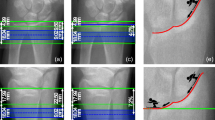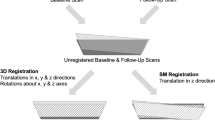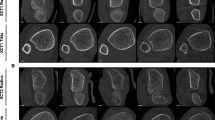Abstract
Peripheral quantitative computed tomography (pQCT) is an essential tool for assessing bone parameters of the limbs, but subject movement and its impact on image quality remains a challenge to manage. The current approach to determine image viability is by visual inspection, but pQCT lacks a quantitative evaluation. Therefore, the aims of this study were to (1) examine the reliability of a qualitative visual inspection scale and (2) establish a quantitative motion assessment methodology. Scans were performed on 506 healthy girls (9–13 years) at diaphyseal regions of the femur and tibia. Scans were rated for movement independently by three technicians using a linear, nominal scale. Quantitatively, a ratio of movement to limb size (%Move) provided a measure of movement artifact. A repeat-scan subsample (n = 46) was examined to determine %Move’s impact on bone parameters. Agreement between measurers was strong (intraclass correlation coefficient = 0.732 for tibia, 0.812 for femur), but greater variability was observed in scans rated 3 or 4, the delineation between repeat and no repeat. The quantitative approach found ≥95 % of subjects had %Move <25 %. Comparison of initial and repeat scans by groups above and below 25 % initial movement showed significant differences in the >25 % grouping. A pQCT visual inspection scale can be a reliable metric of image quality, but technicians may periodically mischaracterize subject motion. The presented quantitative methodology yields more consistent movement assessment and could unify procedure across laboratories. Data suggest a delineation of 25 % movement for determining whether a diaphyseal scan is viable or requires repeat.




Similar content being viewed by others
References
Bachrach LK (2004) Bare-bones fact—children are not small adults. N Engl J Med 351(9):924–926
Binkley TL, Berry R, Specker BL (2008) Methods for measurement of pediatric bone. Rev Endocr Metab Disord 9(2):95–106
Ducher G, Daly RM, Hill B, Eser P, Naughton GA, Gravenmaker KJ, Seibel MJ, Javaid A, Telford RD, Bass SL (2009) Relationship between indices of adiposity obtained by peripheral quantitative computed tomography and dual-energy X-ray absorptiometry in pre-pubertal children. Ann Hum Biol 36(6):705–716
Fricke O, Sumnik Z, Remer T, Stabrey A, Tutlewski B, Schoenau E (2008) Cross-sectional fat area at the forearm in children and adolescents. Horm Res 69(3):160–164
Sherk VD, Bemben MG, Palmer IJ, Bemben DA (2011) Effects of filtering methods on muscle and fat cross-sectional area measurement by pQCT: a technical note. Physiol Meas 32(12):N65–N72
Schoenau E, Neu CM, Beck B, Manz F, Rauch F (2002) Bone mineral content per muscle cross-sectional area as an index of the functional muscle-bone unit. J Bone Miner Res 17(6):1095–1101
Ashby RL, Adams JE, Roberts SA, Mughal MZ, Ward KA (2011) The muscle-bone unit of peripheral and central skeletal sites in children and young adults. Osteoporos Int 22(1):121–132
Reid IR (2008) Relationships between fat and bone. Osteoporos Int 19(5):595–606
Laaksonen MML, Sievänen H, Tolonen S, Mikkilä V, Räsänen L, Viikari J, Lehtimäki T, Kähönen M, Raitakari OT, Group TCRiYFS (2010) Determinants of bone strength and fracture incidence in adult Finns: Cardiovascular Risk in Young Finns Study (the GENDI pQCT study). Arch Osteoporos 5:119–130
Farr JN, Funk JL, Chen Z, Lisse JR, Blew RM, Lee VR, Laudermilk M, Lohman TG, Going SB (2011) Skeletal muscle fat content is inversely associated with bone strength in young girls. J Bone Miner Res 26(9):2217–2225
Zemel B, Bass S, Binkley T, Ducher G, Macdonald H, McKay H, Moyer-Mileur L, Shepherd J, Specker B, Ward K, Hans D (2008) Peripheral quantitative computed tomography in children and adolescents: the 2007 ISCD pediatric official positions. J Clin Densitom 11(1):59–74. doi:10.1016/j.jocd.2007.12.006
Zemel BS (2011) Quantitative computed tomography and computed tomography in children. Curr Osteoporos Rep 9:284–290
Augat P, Gordon CL, Lang TF, Iida H, Genant HK (1998) Accuracy of cortical and trabecular bone measurements with peripheral quantitative computed tomography (pQCT). Phys Med Biol 43(10):2873–2883
Schoenau E (1998) Problems of bone analysis in childhood and adolescence. Pediatr Nephrol 12:420–429
Schoenau E, Neu CM, Rauch F, Manz F (2002) Gender-specific pubertal changes in volumetric cortical bone mineral density at the proximal radius. Bone 31(1):110–113
Rittweger J, Michaelis I, Giehl M, Wusecke P, Felsenberg D (2004) Adjusting for the partial volume effect in cortical bone analyses of pQCT images. J Musculoskelet Neuronal Interact 4(4):436–441
Liu DM, Burrows M, Egeli D, McKay H (2010) Site specificity of bone architecture between the distal radius and distal tibia in children and adolescents: an HR-pQCT study. Calcif Tissue Int 87(4):314–323
Pauchard Y, Liphardt AM, Macdonald HM, Hanley DA, Boyd SK (2012) Quality control for bone quality parameters affected by subject motion in high-resolution peripheral quantitative computed tomography. Bone 50(6):1304–1310
Sode M, Burghardt AJ, Pialat JB, Link TM, Majumdar S (2011) Quantitative characterization of subject motion in HR-pQCT images of the distal radius and tibia. Bone 48(6):1291–1297
Pialat JB, Burghardt AJ, Sode M, Link TM, Majumdar S (2012) Visual grading of motion induced image degradation in high resolution peripheral computed tomography: impact of image quality on measures of bone density and micro-architecture. Bone 50(1):111–118
Pauchard Y, Ayres FJ, Boyd SK (2011) Automated quantification of three-dimensional subject motion to monitor image quality in high-resolution peripheral quantitative computed tomography. Phys Med Biol 56(20):6523–6543
Farr JN, Chen Z, Lisse JR, Lohman TG, Going SB (2010) Relationship of total body fat mass to weight-bearing bone volumetric density, geometry, and strength in young girls. Bone 46(4):977–984
Farr JN, Tomas R, Chen Z, Lisse JR, Lohman TG, Going SB (2011) Lower trabecular volumetric BMD at metaphyseal regions of weight-bearing bones is associated with prior fracture in young girls. J Bone Miner Res 26(2):380–387
Goodpaster BH, Kelley DE, Thaete FL, He J, Ross R (2000) Skeletal muscle attenuation determined by computed tomography is associated with skeletal muscle lipid content. J Appl Physiol 89(1):104–110
Kelley DE, Slasky BS, Janosky J (1991) Skeletal muscle density: effects of obesity and non-insulin-dependent diabetes mellitus. Am J Clin Nutr 54(3):509–515
Shrout P, Fleiss JL (1979) Intraclass correlation: uses in assessing rater reliability. Psychol Bull 86(2):420–428
Barlow SE (2007) Expert committee recommendations regarding the prevention, assessment, and treatment of child and adolescent overweight and obesity: summary report. Pediatrics 120(Suppl):S164–S192
Nunnally JC (1978) Psychometric theory, 2nd edn. McGraw-Hill College, New York
Ducher G, Hill BL, Angeli T, Bass SL, Eser P (2009) Comparison of pQCT parameters between ulna and radius in retired elite gymnasts: the skeletal benefits associated with long-term gymnastics are bone- and site-specific. J Musculoskelet Neuron 9(4):247–255
Cervinkaa T, Hyttinena J, Sievanen H (2010) Enhanced bone structural analysis through pQCT image preprocessing. Med Eng Phys 32:398–406
Fung EB, Vichinsky EP, Kwiatkowski JL, Huang J, Bachrach LK, Sawyer AJ, Zemel BS (2011) Characterization of low bone mass in young patients with thalassemia by DXA, pQCT and markers of bone turnover. Bone 48(6):1305–1312
Wetzsteon RJ, Shults J, Zemel BS, Gupta PU, Burnham JM, Herskovitz RM, Howard KM, Leonard MB (2009) Divergent effects of glucocorticoids on cortical and trabecular compartment BMD in childhood nephrotic syndrome. J Bone Miner Res 24(3):503–513
Hendee WR, Edwards FM (1986) ALARA and an integrated approach to radiation protection. Semin Nucl Med 16(2):142–150
Acknowledgments
We appreciate the participation and support of principals, teachers, parents, and students from the schools in the Catalina Foothills and Marana School Districts. We also thank the radiation technicians and all other members of the Jump-In study team for their contributions. The project was supported by award HD-050775 (S. B. G.) from the National Institute of Child Health and Human Development. The content is solely the responsibility of the authors and does not necessarily represent the official views of the National Institute of Child Health and Human Development or the National Institutes of Health.
Author information
Authors and Affiliations
Corresponding author
Additional information
The authors have stated that they have no conflict of interest.
Rights and permissions
About this article
Cite this article
Blew, R.M., Lee, V.R., Farr, J.N. et al. Standardizing Evaluation of pQCT Image Quality in the Presence of Subject Movement: Qualitative Versus Quantitative Assessment. Calcif Tissue Int 94, 202–211 (2014). https://doi.org/10.1007/s00223-013-9803-x
Received:
Accepted:
Published:
Issue Date:
DOI: https://doi.org/10.1007/s00223-013-9803-x




